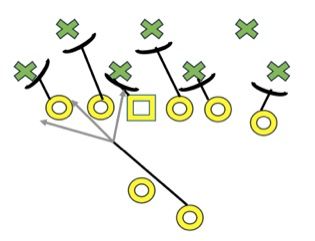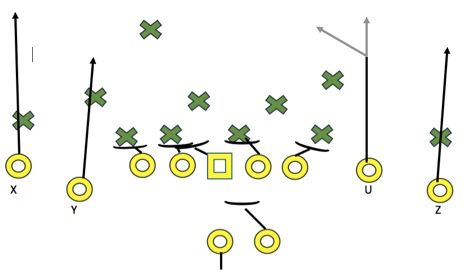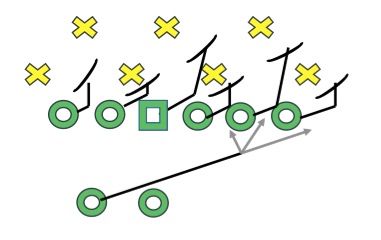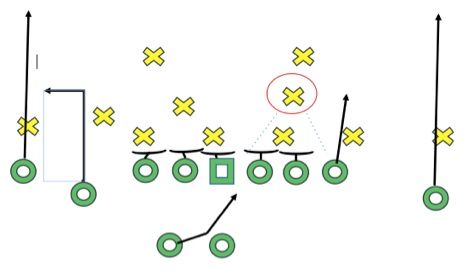Four Plays - Michigan @ Notre Dame - 2014
Four Plays – Michigan @ ND 2014
This series examines the probable individual matchups Michigan expects to face against particular opponents on one each of Michigan’s basic running and passing plays, as well as defensively against a couple of the opponent’s base plays. I did four of these last season, and would have done more, but after games like Penn State and MSU I eventually just became too demoralized to keep going. Not only that, but Borges would install new concepts every other week and I couldn’t keep up.
A new season is upon us, however, so it’s a nice day to start again. For the first 2014 edition of the series, let’s take a look at Michigan’s visit to South Bend in the (sniff) final matchup of this iconic series.
When Michigan has the ball…
1. Inside Zone Left
The Appalachian State UFR showed that RT Ben Braden struggled with his run blocking technique and RGs Joey Burzynski and Kyle Kalis were inconsistent. Michigan should get some help on the right side of the line with Graham Glasgow returning, but the best bet for running the ball may be to go left behind Mason Cole and Erik Magnuson. Shown here from a “Shotgun Deep” formation, this inside zone play is designed to attack the “3-hole” between offensive guard and tackle, but the back must read the blocks and may attack a different hole if a defender gets caught out of his gap or too far upfield. As for Notre Dame, Bob Diaco and his cats & dogs are out; former NY Jets defensive coordinator Brian Van Gorder is in. He supposedly runs an aggressive 4-3, mixing under and over fronts and using lots of pressure.

Assignments:
LT Mason Cole: Covered; block SDE Romeo Okwara, who is covering him
LG Erik Magnuson: Uncovered; release to second-level and block WLB Jaylon Smith
C Jack Miller: Covered; reach block NT Jarron Jones, who is covering him
RG Graham Glasgow: Uncovered; chip DT Sheldon Day, then release to block MLB Joe Schmidt
RT Ben Braden: Covered; block DT Sheldon Day
UTE Khalid Hill: Covered; block WDE Ishaq Williams (haha) Isaac Rochelle, who is covering him
RB – Derrick Green: Receive handoff and aim for 3-hole between LT and LG; read blocks, make a single cut and head downfield
Advantage: ND
Though Cole, Magnuson, and Miller graded out well against Appalachian State, this play calls for Cole, a true freshman, to single-block ND’s upper-classman DE and for Magnuson to hunt down Jaylon Smith—one of the best young linebackers in the country. On the backside, expect Braden to struggle with Sheldon Day, even with help from Glasgow.
2. Four Verticals
Cover 3 gets its name from the three defenders (i.e., both CBs and the FS) who play deep 1/3 zones over top of four underneath defenders. Four Verticals is designed to attack Cover 3 by forcing those three deep defenders to cover four receivers. The outside WRs occupy the two cornerbacks, leaving just the FS to deal with the two inside receivers (the Y and the U, as depicted above). In more advanced versions of the play, one or more of the receivers will run option routes, adjusting their patterns after the snap to exploit the holes in the defensive scheme or coverage techniques. Here, the U receiver will run a fly route—but in the event both safeties drop deep (e.g., in a disguised Cover 2 scheme), he will covert to a post route and attack the open middle of the field.

Assignments:
XWR Amara Darboh: Run fly (9) route vs. BCB KaiVare Russell (doof) Cody Riggs
YWR Dennis Norfleet: Run option fly (9) route vs. FS Max Redfield
LT Mason Cole: Pass protect vs. WDE Ishaq Williams (blarblar) WDE Isaac Rochells
LG Erik Magnuson: Pass protect vs. DT Sheldon Day
C Jack Miller: Pass protect vs. DT Sheldon Day
RG Graham Glasgow: Pass protect vs. NT Jarron Jones
RT Ben Braden: Pass protect vs. SDE Romeo Okwara
RB Derrick Green: Pass protect, then release to flat
UWR Devin Funchess: Run fly (9) route vs. FS Max Redfield
ZWR Jehu Chesson: Run fly (9) route vs. FCB Cole Luke
QB Devin Gardner: 1-step drop (from shotgun); read free safety to see which of the inside receivers he plays tighter on; read “inside-out” on opposite side of field; if corner plays outside receiver, throw to inside receiver and vice-versa
Advantage: Michigan
Successfully defending Four Verticals requires advanced zone coverage technique; the underneath defenders must jam the inside receivers, while the corners and safeties must be able to split their receivers and stay in position to make a play on a ball thrown to either one. Yet ND will be missing its best starting CB due to honor code violations, and starting safety Austin Collinsworth is also out with an injury. To make matters worse for the Irish, starting DE Ishaq Williams is also out because of the academic scandal. That’s a lot of vulnerabilities—and expect Michigan to take full advantage.
When Notre Dame has the ball…
3. Outside Zone
Outside Zone remains the staple of Brian Kelly’s running game. Unlike Inside Zone, a physical running play in which the offensive line tries generally to drive defensive players out of their gaps, Outside Zone calls for agile linemen to step across their defenders and seal them inside (reach blocking). Defenders must fight to avoid being sealed—but in doing so, must also be careful not to flow too far outside, lest they open up cutback lanes behind them.

Assignments:
WDE Frank Clark: Defend backside C-gap vs. LT Ronnie Stanley
NT Ryan Glasgow: Penetrate backside A-gap vs. LG Conner Hanratty (try to demand double team from C)
DT Willie Henry: Penetrate playside B-gap vs. RG Christian Lombard
SDE Brennan Beyer: Fight outside block of TE Ben Koyack to defend playside C-gap; set edge point to force run inside
WLB Joe Bolden: Defend backside B-gap (watch for crackback from invisible slot receiver)
MLB Jake Ryan: Defend frontside A-gap vs. C Nick Martin
SLB James Ross: Defend frontside C-gap vs. RT Steve Elmer
Advantage: Even
Notre Dame has a veteran line with some quality players, but could be shaky on the right side with a young RT and a new starter at TE. Michigan is stout in the middle, but small at SDE and the move to a 4-3 Over base has shuffled their linebackers’ responsibilities around. No clear advantage for either team on this play.
4. Stick/Draw Packaged Play
Notre Dame’s biggest offensive weapons this season are in the backfield, with several touted RBs and QB Everett Golson returning from a one-year academic disqualification. For Michigan, the greatest concerns with the defense lie in the middle of the field—where distinguished SAM linebacker Jake Ryan has moved to MLB, veteran inside linebacker Desmond Morgan is reportedly out with an arm injury, and new (though talented) players start at safety and nickel. One way ND might test these greener players is through a packaged concept that targets the MLB. The line pass-blocks and the TE runs a stick route; the QB reads the MLB to see if he drops into coverage on the TE or plays the run—and then either hands to ball off to the RB (if the MLB drops) or throws to the TE (if the MLB plays the run). This play destroys zone coverage, but Michigan has moved to primarily man-to-man coverage this season.

Assignments:
FCB Blake Countess: Bump & run coverage vs. SE DaVaris Daniels (hoohoo) Chris Brown on fade (9) route
NCB Jabrill Peppers: Coverage vs. Slot WR Amir Carlisle on out (8) route; defend C gap vs. run
WDE Frank Clark: Penetrate C gap vs. LT Ronnie Stanley
NT Ryan Glasgow: Penetrate weakside A-gap vs. LG Conner Hanratty, C Nick Martin
3-tech DT Willie Henry: Penetrate strongside B-gap vs. RG Christian Lombard
SDE Brennan Beyer: Pass rush vs. RT Steve Elmer
WLB Joe Bolden: Read pass or run; against pass, cover RB Cam McDaniel; against run, defend B gap
MLB Jake Ryan: Read pass or run; against pass, cover TE Ben Koyack; against run, defend A gap
SS Delano Hill: Cover deep half
FS Jarrod Wilson: Cover deep half
BCB Raymon Taylor: Bump & run coverage vs. WR Corey Robinson
Advantage: Michigan
This play puts Michigan’s newest starters (Jake Ryan, who is new to MLB, and Delano Hill, who is new to starting altogether) under stress. But Ryan is, as they say, "a football player." And Hill may be a new face at SS, but he’s reportedly a high-IQ guy who should at least be in position. Having a war daddy at the 3-tech position also helps; Lombard is a well-regarded player but if Henry can 2-gap him then the draw play won't work anyhow.
Go Blue!
September 6th, 2014 at 2:42 AM ^
September 6th, 2014 at 3:36 AM ^
September 6th, 2014 at 3:33 AM ^

Comments